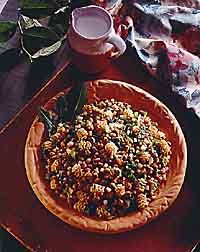Chicory is a diverse vegetable, made up of two types -- root chicory and salad chicory. Both types are featured in several vegetable recipes. In this article, we'll talk about the types and varieties of chicory and show you how to grow chicory.
About Chicory
Chicory is a hardy perennial with two distinct varieties. Cichorium intybus var. intybus, root chicory, is grown mainly for its long fleshy taproot, whereas var. foliosum, salad chicory, Belgian endive or radicchio, is grown for its foliage. Root chicory is a hardy perennial with a rosette of ragged leaves and tall stalks of sky blue summer flowers. Salad chicory is a hardy annual or biennial, grown for its fresh greens. Salad chicory is divided into five groups: radicchio (popular Italian variety), sugarloaf (a popular heading variety), large-leafed chicory, cutting or leaf chicory (Catalogna or asparagus chicory), and Belgian endive or witloof chicory (white or blanched varieties that originated in France and Belgium). The name endive also refers to salad endive.
Advertisement
Common Name: Chicory
Scientific Name: Cichorium intybus
Hardiness: Hardy (may survive first frost)
In the next section, we'll show you how to grow chicory.
Try:
- Vegetable Recipes: Find delicious recipes that feature chicory.
- Vegetable Gardens: Grow a full harvest of great vegetables this year.
- Gardening: We answer your questions about all things that come from the garden.
Advertisement

